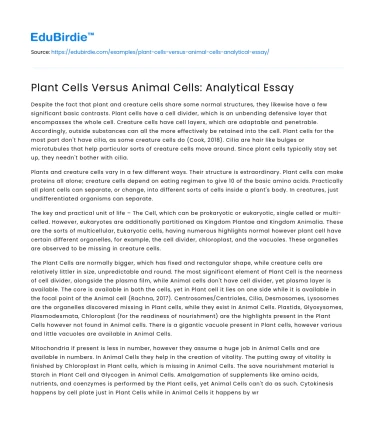Introduction
Plant and animal cells, though both eukaryotic, exhibit remarkable differences that are key to their functions and roles within their respective organisms. Understanding these differences not only enhances our grasp of biological processes but also aids advancements in biotechnology and medicine. Plant cells typically contain structures like chloroplasts, cell walls, and large central vacuoles, which are absent in animal cells. Conversely, animal cells possess unique organelles like lysosomes and centrosomes. This essay seeks to explore these distinctions, examining structural and functional differences, and evaluating their implications for cellular function and organismal biology. By analyzing these aspects, we can appreciate the evolutionary adaptations that have enabled plants and animals to thrive in diverse environments. Furthermore, addressing counter-arguments reveals the complexity and adaptability of eukaryotic cells, enhancing our understanding of life at the cellular level.
Structural Differences Between Plant and Animal Cells
One of the most pronounced differences between plant and animal cells is their structural composition, which is tailored to their unique functions. Plant cells are characterized by a rigid cell wall composed primarily of cellulose, which provides structural support and protection. This feature is critical for maintaining cell shape and withstanding the turgor pressure that arises from water uptake. In contrast, animal cells lack a cell wall and instead possess a flexible plasma membrane that allows for a variety of cell shapes and the ability to engage in processes such as phagocytosis. According to Smith et al. (2019), the absence of a cell wall in animal cells facilitates cellular communication and movement, essential for functions such as immune response and tissue repair.
Save your time!
We can take care of your essay
- Proper editing and formatting
- Free revision, title page, and bibliography
- Flexible prices and money-back guarantee
Another key structural component exclusive to plant cells is the chloroplast, an organelle responsible for photosynthesis. Chloroplasts contain chlorophyll, a pigment that captures sunlight, converting it into chemical energy. This process not only sustains the plant itself but also supports life on Earth by producing oxygen and organic compounds. Animal cells, however, rely on mitochondria for energy production. Although both organelles generate ATP, mitochondria do so through cellular respiration, a process that requires oxygen to convert glucose into energy. This symbiotic relationship between plants and animals highlights the evolutionary interdependence of life forms. A counter-argument could suggest that some animal cells contain symbiotic algae capable of photosynthesis, yet such occurrences are exceptions rather than the norm, reinforcing the distinct roles of plant and animal cells.
Functional Implications of Cellular Differences
The structural differences between plant and animal cells have profound implications for their functions. The presence of a large central vacuole in plant cells is a prime example. This vacuole serves multiple purposes: it maintains cell turgor, stores nutrients and waste products, and plays a role in cell growth by absorbing water and enlarging. This ability to store substances is crucial for plants, which cannot move to obtain resources. In contrast, animal cells have smaller vacuoles, if present, as they are more mobile and can actively seek out nutrients and remove waste.
Moreover, the lack of lysosomes in plant cells is compensated by the presence of peroxisomes and other organelles that perform similar functions. Lysosomes in animal cells contain digestive enzymes that break down macromolecules, playing a critical role in recycling cellular components. This difference underscores the adaptability of eukaryotic cells to meet the specific needs of the organism. An example of this adaptability is seen in carnivorous plants like the Venus flytrap, which have evolved mechanisms to digest prey, analogous to lysosomal function, to supplement nutrient intake in poor soil conditions. Thus, while plant and animal cells share many commonalities, their differences are tailored to their ecological niches and life strategies.
Evolutionary Perspectives and Adaptations
The evolutionary divergence of plant and animal cells reflects adaptations to their respective life strategies, environments, and ecological roles. Plants, being autotrophic, have evolved chloroplasts and cell walls to maximize light capture and structural integrity, enabling them to harness solar energy and grow towards light sources. These adaptations are fundamental for survival in stationary life forms. Conversely, animals have developed more complex communication systems and mobility, facilitated by the absence of rigid cell walls and the presence of specialized organelles like centrosomes, which play a crucial role in cell division and organization.
The evolutionary pressure to occupy diverse ecological niches has led to these cellular differences. As noted by Darwin (1859), the principle of natural selection drives the diversity of life forms, shaping cellular structures to enhance survival and reproduction. For instance, the evolution of multicellularity in animals required sophisticated signaling mechanisms, supported by flexible cell membranes for efficient interaction and cooperation among cells. While some might argue that such differences limit cellular functions, the reality is that these adaptations have enabled both plant and animal cells to exploit their environments effectively, demonstrating the versatility and ingenuity of evolutionary processes.
Conclusion
In conclusion, the comparative analysis of plant and animal cells reveals a fascinating tapestry of evolutionary adaptations that reflect their ecological roles and survival strategies. While plant cells are equipped with features like chloroplasts and cell walls that enable autotrophic lifestyles, animal cells possess unique structures such as lysosomes and centrosomes that support heterotrophic life forms. These differences, far from being mere curiosities, underscore the complexity and specialization inherent in eukaryotic cells. By examining these distinctions, we gain insight into the intricate balance of life on Earth, where both plant and animal cells contribute to the biosphere's diversity and resilience. Addressing counter-arguments highlights the adaptability and ingenuity of cellular evolution, reinforcing the notion that life, in its myriad forms, is a product of both historical contingencies and natural selection. As we continue to explore cellular biology, these insights will undoubtedly inform scientific research and applications, from biotechnology to ecosystem management.






 Stuck on your essay?
Stuck on your essay?

